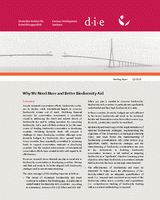Why we need more and better biodiversity aid
Richerzhagen, Carmen / Jean Carlo Rodríguez / Katharina SteppingBriefing Paper 13/2016
Bonn: German Development Institute / Deutsches Institut für Entwicklungspolitik (DIE)
Dt. Ausg. u.d.T.:
Warum die internationale Entwicklungsfinanzierung für Biodiversität ausgeweitet und verbessert werden muss
(Analysen und Stellungnahmen 15/2016)
Despite increased conservation efforts, biodiversity contin¬ues to decline, while international targets to conserve biodiversity remain out of reach. Mobilising financial resources for conservation investments is considered crucial to addressing the direct and indirect drivers of biodiversity loss and to setting incentives for conserving biodiversity. Aid is, and will likely continue to be, the main source of funding biodiversity conservation in developing countries. Mobilising domestic funds still presents a challenge to many develop¬ing countries although some domestic budgets for bio¬diversity show upward trends. Donor countries have repeated¬ly committed to increasing funds to support con¬servation measures in developing countries but the modest achievements of international conservation efforts have created doubts with regard to its effectiveness.
However, research shows that aid can play a crucial role in biodiversity conservation in developing countries. Having said that, aid needs to be better aligned with biodiversity strategies and to aim at mainstreaming.
The main messages of this Briefing Paper are as follows:
The trend of increased biodiversity aid must continue to address the funding gap, in particular in underfunded biodiversity-rich countries. According to estimations, between USD 150 billion and USD 440 billion per year is needed to conserve biodiversity. Biodiversity-rich countries in particular are significantly underfunded and face high biodiversity loss rates. In these countries, domestic budgets are not sufficient by far; hence biodiversity aid needs to be increased. Besides aid, financial resources from other sources (e.g. domestic, private) also need to be mobilised.
Biodiversity aid must support the implementation of national biodiversity strategies, implementing the objectives of the Convention on Biological Diversity (CBD), and must foster the mainstreaming of biodiversity considerations into other sectors (e.g. agriculture, trade). Biodiversity strategies and the mainstreaming of biodiversity considerations are seen as key instruments in fostering biodiversity conservation. Increases in aid marked as targeting biodiversity as a “significant” objective (meaning prime objectives other than biodiversity conservation) indicate that biodiversity has been increasingly mainstreamed.
The effectiveness of biodiversity aid must be improved. To better assess the effectiveness of bio-diversity-related aid, an adequate quantification of needs (i. e. frequent and consistent assessment of the biodiversity status across countries) and expenditures (i. e. comprehensive tracking of biodiversity funding with a consistent methodology) is required.



